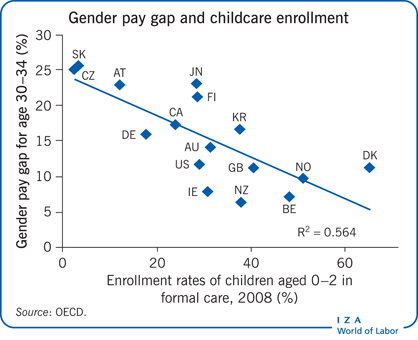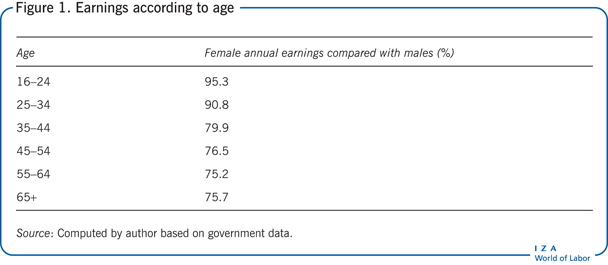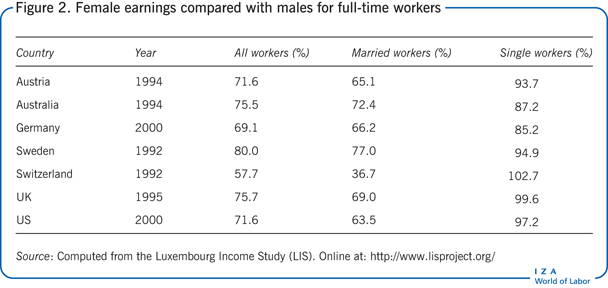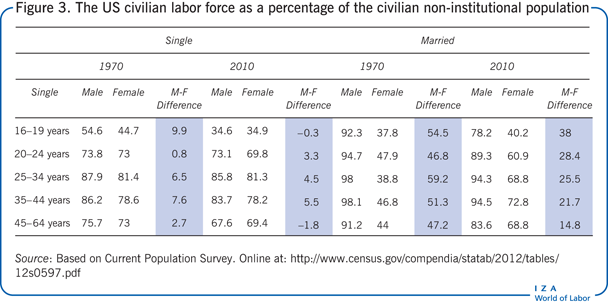Elevator pitch
Despite equal pay legislation dating back 50 years, American women still earn 22% less than their male counterparts. In the UK, with its Equal Pay Act of 1970, and France, which legislated in 1972, the gap is 21% and 17% respectively, and in Australia it remains around 17%. Interestingly, the gender pay gap is relatively small for the young but increases as men and women grow older. Similarly, it is large when comparing married men and women, but smaller for singles. Just what can explain these wage patterns? And what can governments do to speed up wage convergence to close the gender pay gap? Clearly, the gender pay gap continues to be an important policy issue.

Key findings
Pros
Policies promoting greater day care utilization reduce the male–female wage gap.
Policies aimed at increasing women’s lifetime work can reduce the gender wage gap.
The gender wage gap is smallest (2.8%) between single men and single women.
The gender wage gap is decreasing in most countries.
Cons
Audit studies designed to “catch” employers in the act find little evidence of gender discrimination.
Impact studies of the effects of antidiscrimination policies find little effect on reducing the gender wage gap.
The gender wage gap is largest (greater than 25%) between married men and married women with children.
Equal pay legislation may well be missing its target.
Author's main message
Equal pay policies based on wage outcomes have had little effect on the gender wage gap. Policies reducing women’s work, such as marriage taxes, increase the gender wage gap. Strong evidence supports the idea that accumulated human capital narrows the gender wage gap. The gender gap is already decreasing in most countries because changing demographics led to increased women's lifetime labor force participation. Nevertheless, effective policies could speed up wage convergence. However, economic policies that promote even greater lifetime work for women can successfully reduce the gender wage gap further.
Motivation
Some employees earn more than others. As such, pay variation between workers is the norm rather than the exception. While valid economic arguments can explain some of this variation, accounting for why certain demographic groups (such as women) consistently earn less than men is problematic. If the pattern of lower female wages arises because of discrimination, then the economy is inadequately using a large group of valuable potential employees. On the other hand, if unequal economic outcomes result from differing individual choices (despite equal opportunity), then government intervention could lead to a distorted allocation of resources. This results in inefficiencies within the economy. In this case, the economy suffers; and in the long run, women are not helped. Thus, understanding the source of earnings differences is important.
Discussion of pros and cons
Evidence
The first known gender gap estimate is biblical. Leviticus Chapter 27 pegs the monetary difference between prime-age male and female Israelite slaves at 40%. In the US, from 1960 to 1980, women earned 59 cents compared with every dollar earned by men, implying a comparable 41% wage gap. Over time, this wage gap has been more or less declining. It was approximately 70% in 1815, 40% from about 1950 to 1980, and currently it is about 22%.
Interestingly, even within a country, demographic factors influence the gender wage gap. Take the US: Figure 1 indicates the gender earnings ratio by age. For 16–24-year-olds, the earnings gap is 4.7%; yet, for 55–64-year-olds, it rises to a whopping 24.8%. In short, the gender pay gap is relatively small for the young, but systematically increases as men and women age.

Differential pay patterns also emerge when we look at marital status. Single, never-married men earn 2.8% more than single, never-married women. However, between currently married men and women the wage gap is 22.6%.
Children also exacerbate the gap. Each extra child increases earnings differences by between 2% and 10%. Furthermore, children’s detrimental effect on women’s wages relative to men’s is bigger when children are spaced widely apart [1].
The effects of age, marital status, and children hold up not just in the US, but across most countries for which there are data. Figure 2 presents measures for selected countries. Again, the wage gap for married workers is between three and 30 times greater compared with single workers. In addition, as in the US, the earnings gap is wider among men and women with children.

Explanation
Discrimination cannot explain these wage patterns. The Oxford English Dictionary defines discrimination as “the unjust or prejudicial treatment of different categories of people, especially on the grounds of race, age, or sex.” Paying women less than men obviously seems to fit this definition. But, according to Figure 1 and Figure 2, the story is more complicated. Not all groups of women are paid significantly less. The gender wage gap for never marrieds is a mere 2.8%, compared with over 20% for marrieds. The gender wage gap for young workers is less than 5%, but about 25% for 55–64-year-old men and women. If gender discrimination were the issue, one would need to explain why businesses pay single men and single women comparable salaries. The same applies to young men and young women. One would need to explain why businesses discriminate against older women, but not against younger women. If corporations discriminate by gender, why are these employers paying any groups of men and women roughly equal pay? Why is there no discrimination against young single women, but large amounts of discrimination against older married women?
Clearly, gender alone cannot be the explanation; otherwise one would observe a large wage gap between single and young men and women, but we do not see this. One would need a theory of differential discrimination (why discrimination varies by marital status and age) to answer these questions. To date, there is no reasonable theory of differential discrimination. But there is another explanation: The “life-cycle human capital framework” explains why age and marital status affect men’s and women’s wages so differently. It reveals why getting married and having children widen the gender wage gap, and why single and young men and women have comparable wages.
The life-cycle human capital framework
Men and women work different amounts. In 1970 in the US, the married men’s labor force participation rate (the proportion of men at work or actively looking for work) was 86.1%; married women’s was 40.5%. This 45.6% difference implies that more than twice as many married men were working or were actively looking for work than women. Even in 2010, the difference remained stark. For married men, the labor force participation rate was 75.8%, whereas for married women it was 61.0%. For singles, these differences are much smaller. The labor force participation rate was 65.5% for single men and 56.8% for single women in 1970, and 67.3% for single men and 63.3% for single women in 2010.
Gender differences in work also differ dramatically by age and marital status. Columns 3, 6, 9, and 12 of Figure 3 (highlighted) give the difference in labor force participation between men and women. Single men’s and single women’s labor force participation rates vary little over the life cycle. Married male and female labor force participation deviate widely from each other. In short, single men and women accumulate experience at roughly similar rates, but married women accumulate far less labor market experience than married men. Whereas these figures represent average “cross-sectional” data (i.e. taking a snapshot at one point in time), the same results hold up when one uses “longitudinal” data that follow men and women over their lives.

The experience people accumulate over their working lives determines their earnings. The logical reason for this is based on human capital theory. In this framework, individuals invest in skills to enhance their future earnings. They do so through education and on-the-job training. The more years one expects to work, the greater the payoff from these investments. Thus, those who expect to work more tend to enroll in more job-related schooling and then take jobs requiring more continued training. Overall this leads to a somewhat different occupational structure for men and women, sometimes called occupational segregation [2]. Those who expect to drop out of work (perhaps to spend time raising a family, which is less prevalent currently than in previous decades) tend to choose jobs that require less training. These jobs become less obsolete than other jobs during work absences, but have lower wages.
Single women, who have lifetime work expectations equal to those of single men, invest similarly, and so these two groups earn comparable wages. Whereas women starting out in their careers earn wages almost comparable to those of men, they fall behind over time since they accumulate less experience than their male counterparts. There is something of a rebound upon re-entry to the labor force after childbearing and child rearing [3]. A response to this phenomenon is to advocate policies that induce women to work more continuously throughout their lives. Getting rid of marriage taxes and supporting low-cost day care for children are policies consistent with this approach.
Other explanations
The academic literature gives a number of other reasons for the gender wage gap. These include unfair hiring, pay, and promotion practices. These could be explained by: outright corporate discrimination, possibly motivated by corporate monopsony power, given that there are far fewer employers (buyers of labor) than employees (sellers of labor); employer misperceptions regarding women’s relative productivity (statistical discrimination); male employees’ distaste for dealing with female fellow workers; and consumer distaste for purchasing products made or sold by women. While each of these rings true in some way, they are all inconsistent with the evidence.
Let us take each in turn. Outright corporate discrimination (paying higher wages to men for the same job) is incompatible with profit maximization: Profits sink when a firm pays men more, rather than hiring less expensive female employees. Stereotyping based on statistical discrimination is possible in the short term, but surely not in the longer term. Firms cannot sustain long-term losses in a competitive environment either by paying men more or by promoting less qualified men over more qualified women, or simply by misjudging women’s abilities. A male distaste for female coworkers is possible, but if so should result in gender-segregated work environments, not gender wage differences within the company. Consumer distaste for products made and sold by women is also possible, but all too often consumers are not aware who actually makes a product, although they are aware of where the product is manufactured. Relative wages for females in sales roles are no different from those in other occupations. Women earn less than men in (almost) all of the most common occupations, including sales.
Each type of possible discrimination is inconsistent with negligible wage differences among single and younger employees compared with the large gap among married men and women (especially those with children, and even more so for those who space children widely apart). Again, why would companies discriminate against married women, and even more so against married women with children, but not against younger women, or singles? If employers discriminate based on misperceptions of worker productivity or male employee (offensive or derogatory) feelings about working with women, then why do they discriminate against married women, but not single women? Why should children (especially widely spaced children) exacerbate the level of discrimination?
Few studies estimate discrimination directly. However, “audit” studies represent one approach that attempts to catch firms in the act. Early studies of this type sent pairs of trained “auditors,” matched in all respects except the variable being tested (typically gender or race), to rent an apartment, purchase a house, or get a loan. This method has also been used to explore labor markets. Rather than trained auditors, matched resumes are submitted for pairs of job-seekers, again presumably equal in all respects except race or gender.
One often-cited study focuses on race, but by sending out resumes with both (white and African American) male and female names the research also sheds light on gender [4]. This study finds no evidence in the US that firms call women back for interviews less frequently than men. Indeed, it appears women are called about 12% more than men once a job application is submitted. An audit study of restaurant hiring found no gender effects in job offers or interviews in low- and medium-price establishments, although there were significant differences in favor of men for high-price venues.
Another study, using data derived from an Australian experiment, found that female candidates are more likely to receive a callback, with the difference being largest in occupations that are more female-dominated [5]. An audit study in Chile found no significant differences in callback rates across groups based on equivalent CVs varying only in gender, name and surname, and place of residence. Similarly, a “pseudo” audit study (because it used real job applicants) in Peru yielded no significant differences in hiring rates for different gender–race groups.
On the other hand, another study testing how the introduction of blind auditions affected hiring in US symphony orchestras found some evidence that these blind auditions increased the proportion of women [6]. However, a number of this study’s estimates were statistically insignificant, and, in some, the study found the opposite result. Thus, it is not obvious that studies attempting to estimate discrimination directly find strong gender differences in hiring.
Because of difficulties in evaluating government legislation, there are only a few impact studies on equal pay legislation and on more general affirmative action policies, and they yield mixed results. An early analysis based on US data indicates that, despite the introduction of the 1963 Equal Pay Act and Title VII of the 1964 Civil Rights Act, between 1967 and 1974 the male–female earnings differential remained virtually unchanged at 0.68. However, this analysis explains part of this result as possibly being due to the rapid rise in young women’s labor force participation (therefore commanding lower wages because of oversupply), rather than the ineffectiveness of the laws.
With regard to black employment and wages, studies find that most wage gains occurred prior to the establishment of an effective monitoring structure for affirmative action, leading one to be skeptical about the effects of the law. Other studies find virtually no effect arising from affirmative action during the 1980s.
A more recent study, from 2007, based on California’s Proposition 209, which ended the state’s affirmative action programs in education, public employment, and government contracting, concluded that the affirmative action program was either inefficient or failed to change employers’ attitudes [7]. To be fair, advocates of affirmative action legislation argue that the laws do not go far enough: They endorse more comprehensive legislation, including comparable worth, in which men and women are paid based on skill levels rather than on specific jobs.
The weak effects of affirmative action are also observed outside the US. A survey of six countries from 2003 concluded that “there is no universal panacea or prescription for resolving the employment problems of disadvantaged groups,” since current legislation has “achieved mixed success” ([8], p. 214).
Such sentiment is echoed in other country-specific studies. For example, in the case of Japan, one study has shown that since Japan’s Equal Employment Opportunity Law (EEOL) was implemented in 1986, the labor force participation rate for women aged 20–59 years rose from 57.7% in 1980 to 68.5% by 2007. However, women’s participation was increasing anyway because of a number of demographic trends (such as women tending to marry later, or not at all, after graduating from university). The evidence that labor force participation increased because of the legislation was thus not proved. Similarly, although a study based on an examination of equal opportunity progress reports filed in the Australian transport industry found an increased number of women employees in some areas, there were limited increases in the number of women in management.
Strong evidence supports the idea of accumulated human capital as a reason for the gender wage gap. A series of research papers (beginning with [3]) develops a technique to assess the importance of human capital. The technique estimates the amount of human capital a person accumulates based on expected lifetime work. It then determines how well these estimates predict actual earnings. When applied to gender wage differences, it explains between 85% and 100% of the earnings gap. It can also be applied within gender to explain marital status differences in earnings (i.e. why single men earn less than married men, but why single women earn more than married women). In the latter case, discrimination is not an issue, since wages are examined solely for men and solely for women. Here, between 75% and 87% of the marital status differences in earnings are explained by human capital.
Other predictions of the human capital framework are also upheld. The gender earnings gap has consistently declined over the last two centuries in the US from approximately 70% in the early 1800s to the current 22%. Concomitant with this decline, female lifetime work has increased dramatically, while male lifetime work has declined moderately. These gender shifts in lifetime work imply relatively more female than male human capital investment. As a result, women’s earnings should increase relative to men’s. This is precisely what is observed.
Equal pay legislation
There are two issues governing the legal aspects of antidiscrimination policy. One has to do with opportunity, the other with outcome. Equal opportunity implies that such characteristics as race, gender, and religion cannot be used to exclude a person from any job. However, almost always, not allowing individuals to get jobs for which they qualify is economically inefficient. It results in lower profits. For this reason, long-term competitive forces, arising independent of any government action, tend to drive out business enterprises engaging in such discrimination.
Enterprises such as the government, public institutions, and regulated monopolies do not compete in the marketplace. As such, they are not motivated by profits, and they do not have to minimize costs. For this reason, government agencies, non-profit organizations, or overly regulated businesses are capable of discrimination, and hence are more likely to be guilty of unequal opportunity. Past studies corroborate this point for regulated monopolies [9]. Since non-competitive forces are the prime cause of unequal opportunity, the promotion of economic competition is an important weapon to prevent discrimination in opportunity.
Equal pay legislation, and particularly “comparable worth” legislation, deals with outcome rather than opportunity. Equal outcomes entail defining discriminated-against groups simply by the pay that members of these groups receive. Some allege that the lower pay that women on average receive is prima facie evidence of discrimination. However, unequal economic outcomes need not arise from unequal opportunity. As has been implied, unequal outcome can result from personal choice. At least in the past, getting married and having children meant one thing for men and another thing for women. Because women typically bear the brunt of child-rearing, married men with children work more over their lives than married women. This division of labor is exacerbated by the extent to which married women are, on average, younger and less educated than their husbands [1].
Division of labor also explains why single women work more over their lives than married women with children. In contrast, the absence of division of labor is why single men and single women, as well as young men and young women, have comparable work histories. It is also for this reason we observe only a small wage gap between single men and single women (as well as between young men and young women), whereas we observe large gaps between marrieds with children.
Whereas it is not up to governments to determine how much time families spend raising children, the state often sets the costs. High marginal tax rates on wives’ earnings decrease incentives to work. The unavailability of low-cost day care does the same. Nevertheless, some countries provide better opportunities than others. One policy gaining strength in the US is paid family leave. Unfortunately, this policy encourages less rather than more participation. In an analysis by the Organisation for Economic Cooperation and Development (OECD), the gender wage gap in countries with greater paid family leave is larger. On the other hand, in countries with greater day care, the wage gap is smaller.
Limitations and gaps
Women who spend more time in the labor force generally spend less time at home with their families. This could have deleterious effects, particularly on children’s cognitive and social development. At present, there is a large number of studies on these effects, but the conclusions are not definitive. They depend on the socio-economic background of the family, the age of the children, parental attitudes, the gender of the children, and more.
For example, one study indicates that children exhibit significantly more behavioral problems early in life when full-time maternal employment begins before the child is three months old. Another illustrates that the children of mothers who work full-time in the first year of that child’s birth have modestly lower cognitive scores relative to mothers who do not work. On the other hand, a third study shows that in low socio-economic families, child cognitive scores are higher when mothers work. Yet another study finds daughters of employed mothers exhibit higher academic achievement and greater career success.
Summary and policy advice
The conclusion is best described by the US Department of Labor’s Charles James in his summary of a CONSAD Research Corporation study: “the raw wage gap should not be used as the basis to justify corrective action. Indeed, there may be nothing to correct. The differences in raw wages may be almost entirely the result of the individual choices being made by both male and female workers.” This is supported by the almost negligible wage gap data for young men and young women, as well as the relatively small wage gap data for single men and single women. This conclusion is consistent with the human capital approach.
Given changing demographics (in particular, declining fertility rates) and greater female labor force participation, the gender wage gap is already decreasing in most countries. However, effective policies to speed up wage convergence should involve government actions to stimulate a further rise in women’s lifetime work, such as eradicating taxes that decrease wives’ incentives to work. Repealing marriage taxes would increase women’s incentives to invest in education and training, and better enable women to climb the corporate job ladder. Promoting high-quality day care would do the same.
Acknowledgments
The author thanks an anonymous referee and the IZA World of Labor editors for many helpful suggestions on earlier drafts.
Competing interests
The IZA World of Labor project is committed to the IZA Guiding Principles of Research Integrity. The author declares to have observed these principles.
© Solomon W. Polachek